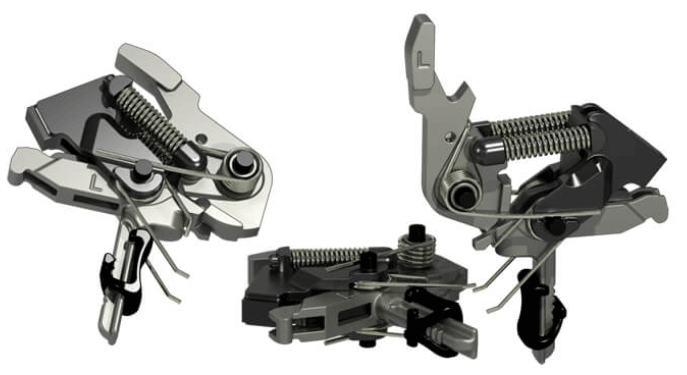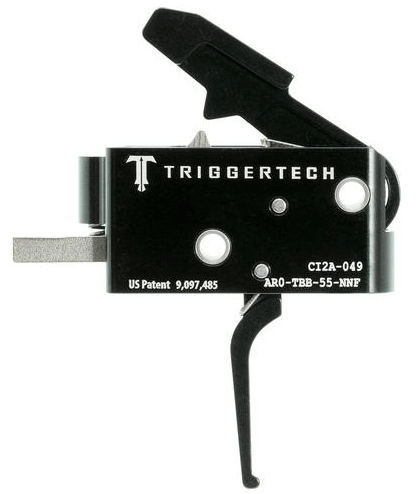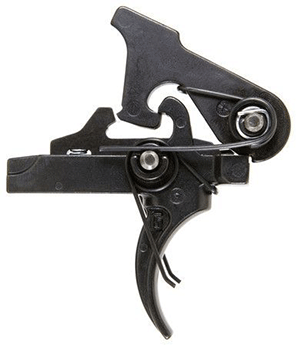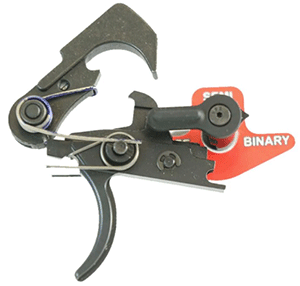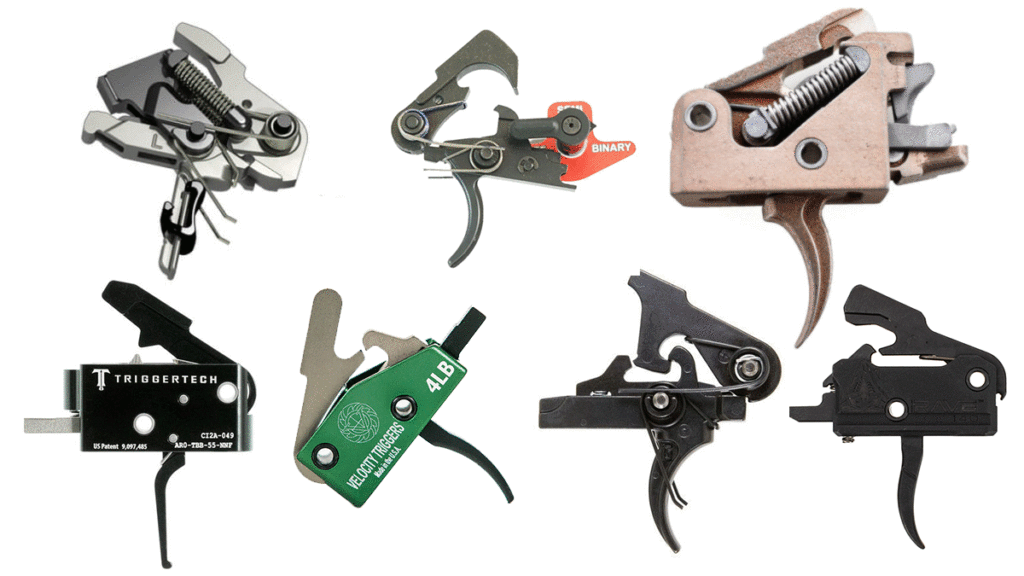
The modern black rifle is a fantastic weapon. In fact, the AR-15 has become America’s favorite rifle by the numbers. Yet with literally tens of millions of 5.56 chambers floating around, many of those guns could use a better trigger pull.
To achieve a better trigger pull, we covered Option #1: Polishing your AR’s trigger to get a crisp break with no creep and little take-up. Today we’re covering Option #2: Drop-in triggers.
Which one’s best? How do they work? Lets’ go.
What is a Drop-in Trigger?
A drop-in trigger is exactly what it sounds like: A preassembled, self-contained fire control mechanism that includes the hammer, trigger, sear, and disconnector. Since the AR-15’s lower receiver is 100% standard across all brands and makes, drop-in triggers can be easily used to upgrade any rifle or pistol chambered in 5.56 NATO, .223 Remington, 300 Blackout (conversion info), 9mm, .308, 6.5 Creedmoor, 6.5 Grendel, you name it.
What’s the Benefit of Drop-in Triggers?
There are a few things AR-15 triggers suffer from, especially when configured in mass production at the factory. To understand these issues better, it helps to know what process a trigger goes through. All triggers work in this sequence:
- Pre-travel, which includes take-up, the “wall”, and creep.
- Break, which is the point at which the sear releases the hammer.
- Over-travel, which is how far the trigger travels after the sear breaks.
- Reset, which describes how far the trigger travels forward to reset the hammer.
Most drop-in triggers focus on improving everything that happens in the pre-travel and over-travel stages.
Key Trigger Terms to Know
Take-up: Take-up describes slack in a trigger. It’s how much “wiggle” movement there is when you begin placing tension on the trigger with your finger. Once you begin to feel the spring in the receiver resisting rearward travel, you’ve overcome initial take-up. Ideally, no single-stage trigger should have any take-up at all. Two-stage triggers have some take-up built in by design. This allows the sear to be placed just before the point of breaking with less pull weight, eliminating creep and improving accuracy at the point of the hammer’s release.
The wall: The wall is that point of initial resistance in rearward travel. This is where you need to exert additional force with your finger to make the trigger overcome the tension of its own spring.
Creep:Creep is the rearward movement the trigger must go through as it compresses the spring inside the receiver before the sear releases the hammer.
How do I Install a Drop-in Trigger?
It’s easy! Your lower receiver holds everything in place with two pins: A hammer pin, and a trigger and disconnector pin. Simply un-cock the hammer, punch both pins out of the receiver (it’s easiest with a punch and small hammer), remove the factory stuff, drop the new trigger in, and put the pins back. No custom modification is required to make a drop-in trigger work in your AR-15. Some triggers come with new pins. These pins typically have detents or grooves to prevent them from “walking” out of the receiver when fired.
Trigger Pin Diameter
The mil-spec AR-15 receiver uses .154”-diameter hammer and trigger pins. Look for this measurement to ensure your drop-in trigger assembly doesn’t require a new set of custom pins when ordering.
Types of Drop-in Triggers
Drop-in triggers don’t just provide better feel and accuracy. Many units come with custom triggers and new, select-fire capabilities.
Single-Stage Trigger
Single-stage units are factory-equivalent in their function: Pull the trigger, and a single round fires. Release the trigger, and the hammer resets. These units tend to focus on improving overall trigger feel, reducing travel, and improving reset for faster follow-up shots.
Two-Stage Trigger
A two-stage trigger purposefully includes some take-up. This allows the shooter to easily approach the point of break, resting the sear “on the edge.” This eliminates all creep and trigger travel before the point of release. This helps reduce muzzle movement and improves accuracy, especially at distance.
Binary Trigger
The fun one. The binary trigger is a new type of select-fire unit that releases the sear and drops the hammer on the rearward pull and on the forward reset of the trigger itself. So, pull, bang, release, bang. These units are capable of achieving nearly automatic rates of fire without any other modifications. These units take advantage of the factory safety lever, adding that mythical third position where automatic fire would normally be selected.
Adjustable/Hair Trigger
Some shooters prefer making the trigger as light as possible. Modifying a factory trigger to reduce the pull weight could be dangerous, but drop-in units can provide safe fine-tuning and pull-weight adjustments down to below 1 pound of force. These are great for accurizing any rifle on the cheap.
Best AR-15 Drop-in Triggers
Now that you’re all learned up, let’s look at the best drop-in triggers available for your favorite AR.
1 – Rise Armament Rave 140
Starting off our list is a popular all-rounder that provides plenty of features at a great price. It’s also backed up with high regard from quite a few shooters. The RA-140 Trigger is in its second generation, providing new anti-walk pins for the install. This is a nonadjustable single-stage unit built with what Rise Armament calls their Quik-Klik™ reset. It aims to eliminate over-travel for quicker reset, and it works quite well.
This trigger can be purchased at the following retailers:
- Brownells Rise Armament Rave 140
- Optics Planet Rise Armament Rave 140
- Primary Arms Rise Armament Rave 140
Total pull weight is just 3.5 pounds, shaving off about 2 pounds over the average factory mil-spec trigger setup. The whole trigger’s made from S7 tool steel and is hardened with a matte black nitride treatment and the housing is black-anodized billet aluminum, so it’ll blend in nicely with any typical anodized receiver. We like the modified trigger bow; it’s less curved and provides a more linear feel than a factory bow but it doesn’t quite approach the straight-lever look of other triggers.
- MSRP: $139.00
- Trigger Pull Weight: 3.5 pounds
- Configuration: Nonadjustable, Single-stage
- Material: S7 tool steel, billet aluminum
- Finish: Type III anodizing, QPQ nitride salt bath
- Compatibility: All mil-spec receivers, 5.56/.223, .308, 6.5, 9mm
2 -Steel-Cased AR Trigger by Velocity
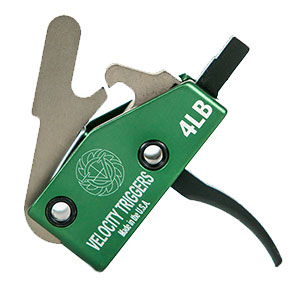
The Steel-Cased AR Trigger by Velocity is a wonderful entry-level unit that affords impressive performance. If you want to spend as little as possible on a quality upgrade and you’re only interested in improving trigger feel, look no further. This single-stage reduces pull weight to 4 pounds. Every ounce of design went into eliminating take-up, creep, and over-travel.
Shooters report a crisp pull that’s consistent with a very fast and short reset.
This trigger is are available at the following retailers:
All wear surfaces are coated with Diamond-Like Carbon Coating (DLCC). This DLC treatment polishes the assembly, eliminates the need for lubrication, and makes for a very consistent feel. Velocity says DLC was also used to guarantee the trigger and hammer can handle steel-cased ammo without failure. The Velocity Trigger can be configured with a curved or straight bow.
- MSRP: $159.00
- Trigger Pull Weight: 4.0 pounds
- Configuration: Nonadjustable, Single-stage
- Material: Stainless steel, billet aluminum
- Finish: Type III anodizing
- Compatibility: All mil-spec receivers (no AR-9/9mm or AR-10/.308)
3 – Hiperfire Hipertouch AR-15 Trigger Series
Hiperfire’s been making some pretty crazy-looking triggers, and their designs back up the bright colors and dozens of springs. The Hipertouch series is a collection of some of the easiest-to-adjust drop-in triggers, with no set screws to tinker with. Instead, multiple springs are provided to fine-tune pull weight at 2.5 or 3.5 pounds.
Trigger options include the Eclipse, Competition, Reflex, Elite, Genesis, and Auto. Each model comes with slightly different specifications: Some maintain a factory-like take-up and creep, simply because many AR-15 have learned that factory feel. Others have micro-resets or no over-travel for quicker groupings. All Hipertouch triggers are adjustable single-stage units that are mil-spec in fitment.
These triggers are available from the following retailers:
- Brownells – Hiperfire Hipertouch
- Optics Planet – Hiperfire Hipertouch
- Palmetto State Armory – Hiperfire Hipertouch
- Sportsman’s Guide – Hiperfire Hipertouch
Hiperfire touts their “Cam-Over Toggle Engine”, which increases the hammer strike force while helping to make trigger pull feel less elastic and more linear. Lastly, the adjustable “Hipershoe” finger pad works with all Hiperfire models and allows you to easily customize your trigger’s length, curve, and felt resting position.
- MSRP: $200.00 to $275.00
- Trigger Pull Weight: 2.5 pounds or 3.5 pounds
- Configuration: Adjustable, Single-stage
- Material: Stainless and carbon steel, billet aluminum
- Finish: Type III anodizing, stainless, or Nickel Boron (NiB)
- Compatibility: All mil-spec receivers (no AR-9/9mm or AR-10/.308)
4 – Triggertech TT-AR-15 Trigger
Triggertech designed the TT AR-15 Trigger with some pretty insane features. It’s also the first two-stage on our list. This trigger uses modified springs and pins to provide what Triggertech calls “Zero Creep Release.”
Its first-stage pull is light but tactile, the point of break is right on a knife’s edge, and the reset after the break is unmatched: Around 0.03” of forward travel is all that’s required for the sear to cock, making for instant follow-up shots with almost no travel.
These triggers are available at the following retailers:
The TT’s components are made entirely from 440C stainless while the housing is anodized aluminum. Four variants are available:
- Diamond: Adjustable, 0.25 lbs 1st stage pull, 1.25 to 3.75 lbs 2nd stage.
- Adaptive: Adjustable, 0.75 lbs 1st stage pull, 1.75 to 4.25 lbs 2nd stage.
- Competitive: Fixed, 0.75 lbs 1st stage pull, 2.75 lbs 2nd stage.
- Combat: Fixed, 1.5 lbs 1st stage pull, 4.0 lbs 2nd stage.
- MSRP: $210.00 to $280.00
- Configuration: Adjustable or Nonadjustable, Two-stage
- Material: Stainless, billet aluminum
- Finish: Raw stainless, anodizing, PVD
- Compatibility: All mil-spec receivers, 5.56/.223, .308, 6.5, 9mm
5 – Geissele Automatics G2S Two-Stage Trigger
Geissele needs little introduction, especially if you’re familiar with the black rifle market. They’ve developed custom triggers and weapons for special operations, counterterrorism, and militaries globally. They put that contractor quality into the two-stage G2S trigger, which comes in at a surprising price point for having the Geissele name on the box.
No laser engravings or markings here; all business.
These triggers are available at the following retailers:
This trigger’s purposefully mil-spec in its appearance and design, but it affords a buttery smooth 2.5-lb. initial take-up with a crisp 2.0-lb break. This unit was made for reliability, with EDM wire cut from heavy-duty tool steel for the springs. It’s also been MPI-inspected like a bolt carrier to ensure no cracks or defects in workmanship make their way into your receiver.
- MSRP: $165.00
- Trigger Pull Weight: 2.5 pounds, 2.0 pounds
- Configuration: Nonadjustable, Two-stage
- Material: Tool steel
- Finish: Matte black mil-spec coating
- Compatibility: All mil-spec receivers and calibers
6 – Franklin Armory BFSIII AR-C1
Want something that approaches full-auto? The king of the drop-in world at the moment, Franklin Armory’s BFSIII AR-C1 trigger boasts an eight-week lead time on production due to popular demand. With a mil-spec-ish design and nearly automatic rate of fire, the BFSIII nearly replicates the look and feel of a service-issued M4.
Safety lever position 1 is Safe. Position 2 is the usual semiautomatic fire. Position 3 replaces full-auto fire with the binary function: Pull, fire, release, fire.
Importantly, the binary function can be eliminated after the initial trigger pull by keeping the trigger depressed and flipping the safety lever back to semiautomatic or safe. This will de-cock the sear and prevent the hammer from dropping on the trigger’s release.
This crazy trigger is available at the following retailers:
This wicked trigger works with all bolt carriers and all calibers that fit in the mil-spec AR lower. It even works with 80% lowers for those of who you want to go full “scary-off-the-books-survival-black-rifle.”
- MSRP: $429.00
- Trigger Pull Weight: 4.5 lbs. +/- 0.5 lbs.
- Configuration: Nonadjustable, Semi, Binary
- Material: Tool steel
- Finish: Matte black mil-spec coating
- Compatibility: All mil-spec receivers and calibers
7 – Fostech Echo AR-II Binary Trigger
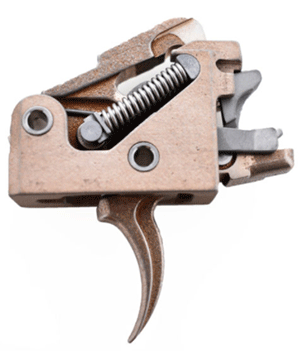
Here’s the pinnacle, folks. Fostech took the same principles as Franklin Armory’s BFSIII and took it a few steps further. The AR-II Binary is another custom, select-fire trigger that provides safe, semi, and “echo” (binary) firing modes.
Interestingly, the AR-II uses actual, licensed design elements from Franklin Armory and Hiperfire to achieve the highest possible cyclic rate in echo mode, while building in redundant safeties that prevent a runaway hammer or slam-fire discharge.
This trigger is available at the following retailers:
It’s the most expensive and most well-executed trigger on our list. It’s made from a proprietary stainless steel alloy with a custom anodized-like coating, and a 4.5-lb. pull weight, nonadjustable. For its complex appearance, the Fostech still works with all mil-spec AR lowers and calibers that fit without additional modification.
- MSRP: $479.00
- Trigger Pull Weight: 4.5 lbs. +/- 0.5 lbs.
- Configuration: Nonadjustable, Semi, Echo (binary)
- Material: Custom stainless steel
- Finish: Custom anodized-like gold finish
- Compatibility: All mil-spec receivers and calibers
Hopefully, our top picks helped you figure out which trigger’s the best drop-in upgrade for your AR-15. Ready to take your marksmanship a step further? Check out some sniper tips you’ve never heard, straight from the Department of The Army’s top shooters.


